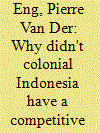| Srl | Item |
| 1 |
ID:
128623


|
|
|
|
|
| Publication |
2014.
|
| Summary/Abstract |
Australia is currently negotiating a framework treaty with the European Union (EU) that aims at closer cooperation on a wide range of shared policy goals. The treaty is not expected to include trade-liberalisation commitments. This article queries why this is, given the importance of trade and business relations with the EU for Australia, and the fact that the EU exerts international influence primarily as a trade power, rather than a foreign and security policy power. Since 2006, the EU has also been negotiating 'new-generation' bilateral free trade agreements (FTAs), focusing on tariffs and regulatory non-tariff trade barriers. It has now committed itself to FTA negotiations with many of Australia's trade partners in Asia and the Organisation for Economic Co-operation and Development. An FTA and a complementary framework treaty were concluded with South Korea in 2010, and the EU is currently negotiating a similar package with Canada. As Australia and Canada are comparable trade partners for the EU, the article argues that an FTA on the EU-Canada model could be a more effective avenue for Australia to achieve deeper engagement with the EU.
|
|
|
|
|
|
|
|
|
|
|
|
|
|
|
|
| 2 |
ID:
121962


|
|
|
|
|
| Publication |
2013.
|
| Summary/Abstract |
This paper quantifies the consumption and production of cotton textiles at different stages of processing in Indonesia during the Dutch colonial era (1820-1941). It discusses the main factors that impeded the development of an internationally competitive cotton textile industry, and concludes that production in the industry increased significantly in Java during 1820-71, and again during 1874-1914 and 1934-41. However, most activity involved finishing of imported cotton cloth to suit local preferences. Spinning and weaving increased only marginally, as domestic production was precluded by the high-labour intensity of small-scale production, marginal local raw cotton production, and competitive international markets for yarn and cloth. Unfavourable and fluctuating real exchange rates discouraged investment in modern spinning and weaving ventures until trade protection and technological change in small-scale weaving caused rapid growth of domestic production after 1934.
|
|
|
|
|
|
|
|
|
|
|
|
|
|
|
|